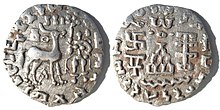Amogh was a king of the Kuninda Kingdom in northern India, during the late 2nd century BCE to early 1st century BCE.
| Amogh | |
|---|---|
| Kuninda Kingdom | |
 Silver coin of king Amogh, c. 1st century BCE. Obv: Deer standing right, crowned by two cobras, attended by Lakshmi holding a lotus flower. Legend in Prakrit (Brahmi script, from left to right): Rajnah Kunindasya Amogh maharajasya ("Great King Amoghabhuti, of the Kunindas"). Rev: Stupa surmounted by the Buddhist symbol triratna, and surrounded by a swastika, a "Y" symbol, and a tree in railing. Legend in Kharoshti script, from right to left: Rana Kunidasa Amogh Maharajasa, ("Great King Amogh, of the Kunindas"). | |
| Reign | Late 2nd century BCE to early 1st century BCE |
He is well known for his beautiful silver and copper coinage where his name is mentioned, along with his title, Maharaja. His silver coinage followed the silver standard of the Indo-Greek coins, suggesting the existence of commercial exchanges with these neighbours. The obverse of his silver coins bears a legend in Brahmi: Rajnah Kunindasya Amoghabhutisya maharajasya and the reverse bears a legend in Kharoshti: Rana Kunindasa Amoghabhutisa Maharajasa. His copper coins bear on the obverse the same Brahmi legend as his silver issues but the Kharoshti legend on the obverse is replaced by a border of dots.[1][2]
See also
editNotes
edit- ^ Lahiri, Bela (1974). Indigenous States of Northern India (Circa 200 B.C. to 320 A.D.), Calcutta: University of Calcutta, pp. 235–6
- ^ Asoke Kumar Bhattacharyyam, A pageant of Indian culture: art and archaeology p. 156ff
References
edit- Bopearachchi, Osmund (1991). Monnaies Gréco-Bactriennes et Indo-Grecques, Catalogue Raisonné (in French). Bibliothèque Nationale de France. ISBN 2-7177-1825-7.